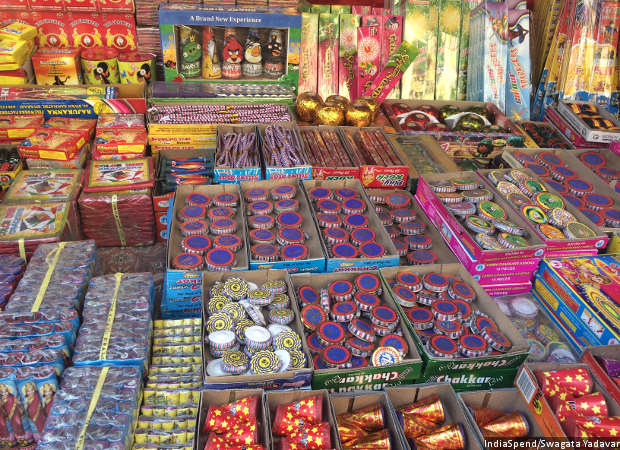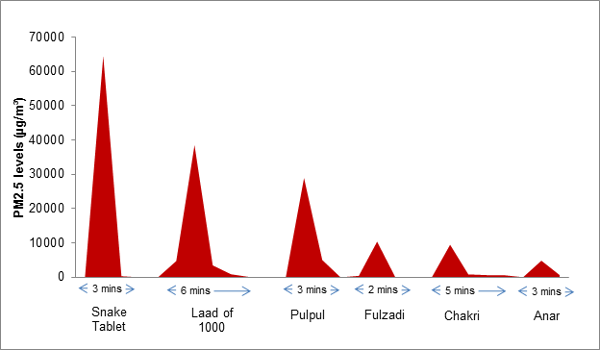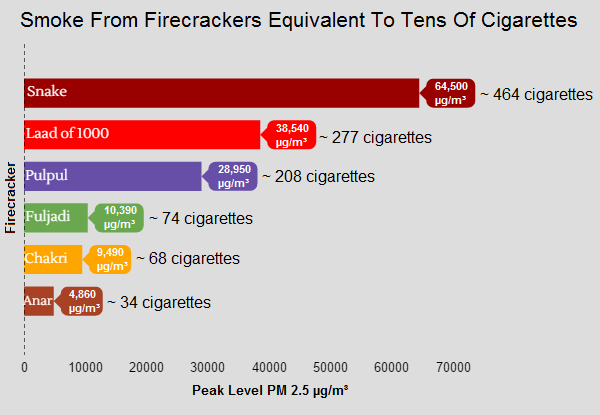Smoke From Firecracker Snake = 464 Cigarettes (And Other Diwali Stories)
Would you be comfortable sending your child into a room filled with smoke from 464 cigarettes? That is equivalent to the amount of particulate matter less than 2.5 microns (PM 2.5) emitted by the popular firecracker called a snake tablet.
Six popular firecrackers--the snake tablet, the laad (string of 1,000 crackers), fuljhadi (sparkler), the pul-pul (string sparkler), anar (flower-pot), chakri (spinning firecracker)--emit particulate matter 200 to 2,000 times the safe limits as designated by the World Health Organization (WHO), according to this 2016 study by the Chest Research Foundation, Pune, and students from the Interdisciplinary School of Health Sciences of the University of Pune.
The study used a light-scattering photometer, which counts the number of particles and converts them into mass, then expressed as µg/m³. The photometer recorded minute-by-minute levels of PM 2.5 over the duration of the study. The firecrackers tested were kept at distances normally kept by those who light them: For instance, the fuljhadi was kept at a distance of 1 ft, while the laad and anar were kept at a distance of 6 ft.
The study found the snake tablet produced the highest amount of PM 2.5, followed by the laad, pulpul, fuljhadi, chakri and anar.
Pollution From Popular Firecrackers: Duration & Peaks
Source: Study by the Chest Research Foundation, Pune, and students from the Interdisciplinary School of Health Sciences of the University of Pune
IndiaSpend analysed the study results and compared them to the PM 2.5 emitted by a single cigarette in a closed room of 50 m³, as this 2014 study published in medical journal Tumori did, to get the equivalent of cigarettes inhaled.
Source: IndiaSpend calculations based on study published in Tumori, 2014Mean PM 2.5 emitted by a typical cigarette in a room of 50 m³ is around 139 µg/m³.
Although the snake tablet burnt for only nine seconds, it produced the highest peak of PM 2.5 (64,500 mcg/m3)--the equivalent of smoke from 464 cigarettes--while the laad, which burnt for 48 seconds, produced high PM 2.5 levels of 38,540 µg/m³, equivalent to particulate matter emitted by 277 cigarettes.
The snake, laad and pul-pul were the top three PM 2.5 producers, while the anar produced the lowest amount of PM 2.5. The anar perhaps produced the lowest levels because the smoke was measured at a height of 3 ft and a distance of 6 ft or it had better combustion, the researchers inferred.
In general, particulate matter is considered dangerous to humans since it can reach the deepest portions of the lung. It is declared as a class 1 carcinogen by the International Agency for Research on Cancer and is also linked to heart disease and respiratory ailments.
PM 2.5, 30 times finer than a human hair, is even more dangerous due to its tiny size and ability to accumulate in human organs and blood.
India has set a 24-hour mean standard of 60 µg/m³ for PM 2.5, while the WHO has a lower standard of 25 µg/m³.
Children with weak immune and respiratory responses are particularly vulnerable. “Children, in particular, burn the fuljhhadi, the pul-pul and the snake tablet barely a foot or two away from them, and in doing so, (they) inhale a large number of smoke particles that reach deep into their lung,” Sneha Limaye, senior scientist at the Chest Research Foundation, told IndiaSpend.
The levels of PM 2.5 were measured only when an individual firecracker was burnt, but in real terms, many people burn many firecrackers together, which means the cumulative levels of PM 2.5 could reach “extremely high levels”, the researchers wrote.
Firecrackers not only release particulate matter but also other harmful gases, such as nitrogen dioxide and sulphur dioxide. This 2014 study found that air pollutants were two to six times higher during Diwali than on normal days.
“The extremely high levels of air pollutants generated during the burning of firecrackers causes worsening of asthma, allergic diseases of the eyes and nose, respiratory tract infections, pneumonias and heart attacks,” wrote Sundeep Salvi, director of the Chest Research Foundation.
(Yadavar is principal correspondent with IndiaSpend.)
We welcome feedback. Please write to respond@indiaspend.org. We reserve the right to edit responses for language and grammar.
__________________________________________________________________
“Liked this story? Indiaspend.org is a non-profit, and we depend on readers like you to drive our public-interest journalism efforts. Donate Rs 500; Rs 1,000, Rs 2,000.”





